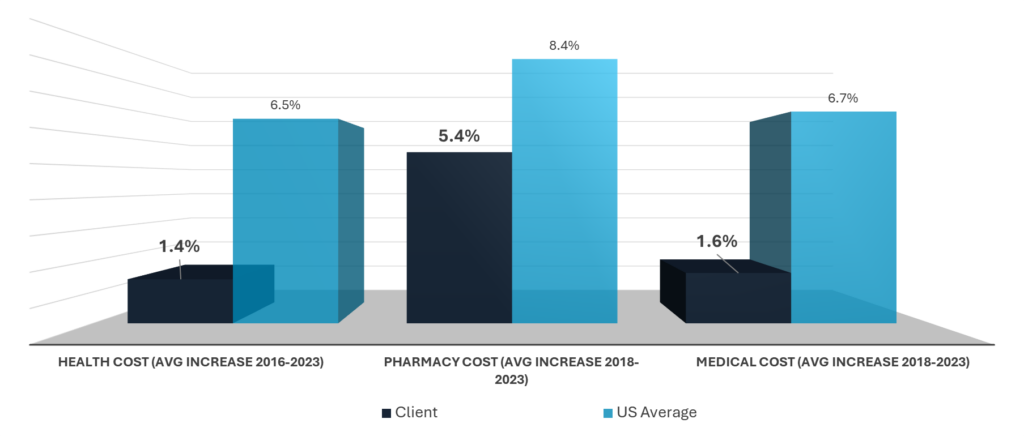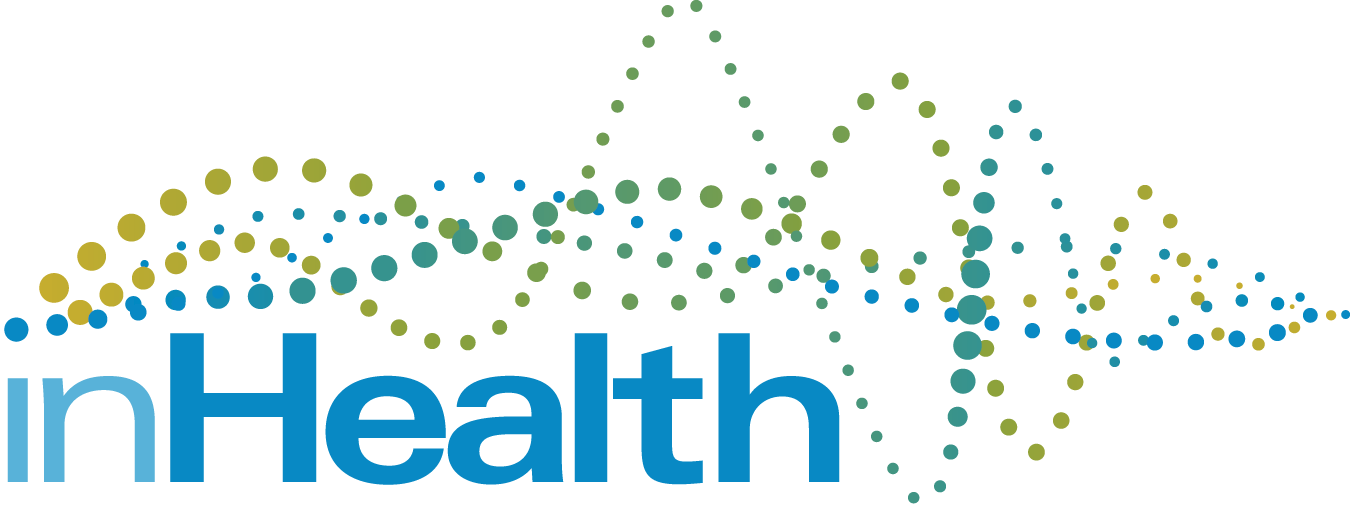Hospitals operate in high-stress environments where employees, especially healthcare providers, are at risk for burnout, fatigue, and other wellness challenges. Implementing a tailored hospital wellness program can improve employee health, enhance patient care, and significantly reduce costs by addressing absenteeism, turnover, and high-cost health conditions.
With our evidence-based approach, inHealth has helped hospitals achieve measurable results, including a 5.7% reduction in overall costs by combining health awareness, primary care engagement, and targeted prevention strategies. Here’s a step-by-step guide to building an effective hospital wellness program and maximizing your return on investment.
1. Understand Workforce Needs Through Data
The foundation of any effective hospital wellness program lies in understanding the unique needs and challenges of your workforce. At inHealth, our expert clinicians and data analysts begin this process by meticulously collecting and analyzing diverse data streams, including:
- Employee Health Data: Use aggregated, anonymized health risk assessments (HRAs) to identify prevalent health conditions, such as high blood pressure, diabetes, or stress.
- Engagement Surveys: Learn what employees value, such as mental health resources or work-life balance support.
- Operational Metrics: Review absenteeism, turnover, and productivity data to identify gaps.
In addition to identifying general trends, inHealth goes further by stratifying population health data to pinpoint the highest-cost conditions impacting your workforce. This enables targeted interventions that not only improve employee health but also drive significant reductions in medical and pharmacy expenses. To maximize these efforts, collaborate with your health insurance provider or benefits administrator, using inHealth’s actionable recommendations to address these high-cost areas while enhancing overall wellbeing and reducing operational costs.
Workforce Wellbeing: Keys to Better Care and Cost Savings
Furthermore, inHealth’s sophisticated data and analytics capabilities empower HR leaders to defend the value of their hospital wellness programs convincingly. By providing clear, data-driven insights and measurable outcomes, we help HR professionals articulate the tangible benefits of their investments in employee health, aligning wellness initiatives with broader organizational goals and ensuring sustained support from senior management.
2. Develop Clear Goals and Objectives for Your Hospital Wellness Program
Effective hospital wellness programs have measurable goals tied to employee wellbeing and organizational performance. Examples include:
Increase HRA completion rates to better define and understand our member population.
- Lowering healthcare costs by implementing preventive care initiatives.
- Increase employee engagement scores by supporting and incentivizing annual wellness visits and preventive care screenings into the workplace wellness initiatives.
Define both short-term objectives, like piloting a mindfulness program, and long-term aspirations, such as building a wellness-focused culture.
3. Demonstrate Leadership Buy-In
For a wellness program to succeed, hospital executives must visibly support and champion the initiative. Leaders can set the tone by:
- Communicating the Program’s Value: Reinforce its importance in meetings and communications.
- Allocating Resources: Provide adequate budget and staffing to ensure sustainability.
- Modeling Healthy Behaviors: Actively participate in wellness challenges or activities to inspire engagement.
When leadership visibly champions wellness, it signals its importance to employees and fosters a supportive culture.
4. Create an Effective Wellness Staff Structure
A dedicated team ensures the program runs smoothly. Consider the following roles:
- Wellness Director and Coordinator: Oversee alignment with organizational goals and daily operations.
- Health Coaches: Provide personalized coaching to address specific needs.
- Third-Party Consultant: inHealth enhances programs by analyzing health data, integrating tools, and providing data-driven, targeted communications.
Collaborative planning and regular training help maximize the program’s impact.
5. Tailor Programs to the Unique Challenges of Healthcare Workers
Healthcare employees face irregular hours and emotional demands. Address these challenges with:
- Flexible Wellness Activities: Offer virtual fitness classes and on-demand mental health resources.
- Shift-Friendly Solutions: Provide healthy meal options and 24/7 relaxation zones.
- Stress Management Training: Equip employees with tools to manage trauma and stress.
Focus on high-risk groups, like nurses or emergency staff, with specialized programs.
6. Incorporate Mental Health Support
Mental health is a critical component of a hospital wellness program. Include:
- Counseling Services: Promote EAP offerings for confidential, no-cost sessions.
- Resilience Training: Help employees better manage stress with workshops.
- Stigma-Free Culture: Train leaders to normalize mental health conversations.
7. Foster a Culture of Wellness
Embed wellness into your organization’s culture with strategies like:
- Visible Leadership: Encourage managers to participate in wellness initiatives.
- Aligned Incentives: Collaborate with third-party administrators to offer rewards like HRA contributions or waived surcharges.
- Team Challenges: Promote camaraderie with step challenges or healthy eating competitions.
- Mindful Practices: Provide quiet spaces or guided meditation sessions to support mental clarity.
Make wellness a core part of onboarding and annual evaluations to reinforce its importance. inHealth’s communications team can help you craft and promote your messaging for higher engagement and participation.
8. Leverage Technology for Engagement
Use technology to make participation easy and trackable:
- Wellness Platforms: The inHealth Wellbeing app combines goal setting, health tracking, healthy resources, and gamification.
- Educational LMS Programs: Offer short, interactive modules on nutrition, fitness, and mental health. inHealth’s LMS programs also include a robust library of microlearning modules covering all dimensions of wellness, making it easier for employees to access valuable insights in short, engaging formats.
- Wearable Devices: Partner with vendors to offer discounted fitness trackers that sync with the wellness program.
These tools enable employees to engage on their terms while providing HR leaders with valuable program data that can be used to track efficacy and program participation.
9. Measure and Adjust
Regular evaluation ensures your program remains relevant and effective. Key metrics to monitor include:
- Participation Rates: Are employees engaging with the program?
- Health Outcomes: Are there reductions in chronic conditions or improvements in mental health scores?
- Financial Impact: Are healthcare costs and absenteeism rates decreasing?
inHealth can help HR leaders promote the value of their hospital wellness programs with trusted data and meaningful analytics to identify cost-saving opportunities and refine interventions. This ensures the program delivers both health improvements and measurable financial benefits.
11. Collaborate with Trusted Partners
Hospitals and HR leaders don’t have to build wellness programs from scratch. Collaborate with:
- Partner with inHealth: We come from hospitals and healthcare backgrounds, so we understand workplace wellness in this space.
- Local Community Resources: Leverage local gyms, nutritionists, or wellness coaches for added support.
11. Communicate Effectively
Transparent, consistent communication is vital to driving engagement. Use multiple channels, such as email, wellness portal and app, intranets, and digital signage, to:
- Announce new programs or updates.
- Share success stories and testimonials from employees.
- Provide ongoing tips and reminders to encourage participation.
Craft messaging that resonates with healthcare employees, focusing on how wellness initiatives help them care for themselves so they can better care for patients. The inHealth communications team offers support and guidance for enhancing for messaging campaigns and promotional strategies that complement existing internal communications.
inHealth can help your wellness program deliver results and costs savings
An effective wellness program for hospitals and hospital systems goes beyond perks like gym memberships. It addresses the unique challenges faced by healthcare employees while fostering a culture of health and support. By prioritizing mental health, leveraging technology, and using data-driven insights with the help of inHealth Strategies, HR leaders can create a program that enhances employee wellbeing, boosts morale, and aligns with the mission of delivering high-quality patient care.
Why Choose inHealth: Data-Driven Insights, Custom Programs, Proven Results
inHealth was founded by an experienced physician who developed a highly effective wellness program for a health system, addressing the unique challenges faced by healthcare workers. This origin gives inHealth unparalleled insight and expertise, making it uniquely positioned to partner with hospitals and health systems to design and implement tailored wellness programs that drive meaningful results.
We know how to help hospitals define what their resources are and how they can be leveraged for a wellness program, and we combine that understanding of client needs with clinical expertise and data-driven insights to provide the greatest return on investment.
Our expertise in implementing value-based, data-driven programs and population health solutions translates directly into cost savings and better care outcomes. With a proven record of adopting cutting-edge technology, we help reduce health plan costs while enhancing member engagement and satisfaction.

At inHealth Strategies, we’re more than consultants—we’re committed partners, driven by a shared mission to improve health outcomes and support healthcare organizations on their journey to a healthier population.
Our team of dedicated clinicians, healthcare specialists, and communication experts collaborates with hospitals and health systems to maximize their existing resources—people, processes, and technology—for impactful population health and care management.
Contact us today to learn more about how inHealth Strategies can bring a tailored, value-based wellness programs to your organization.



